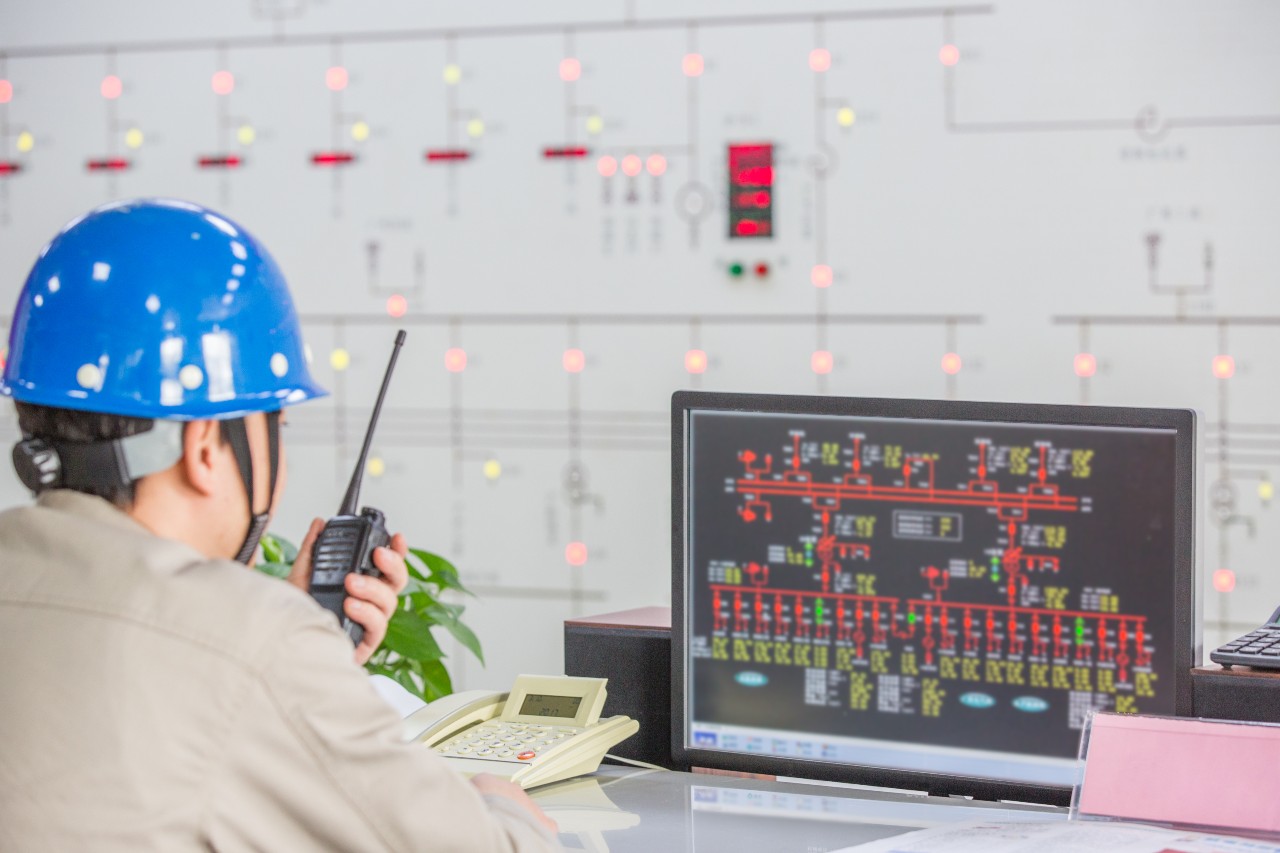In the past, a Programmable Logic Controller (PLC) couldn’t manage the control of an entire plant. Plants were just too much ground to cover. That’s where the Distributed Control System (DCS) came in.
Unlike the PLC, the DCS doesn’t regulate individual processes. Instead, it oversees and coordinates all the controllers spread throughout a plant. This ability to manage operations across the entire plant has become increasingly important for manufacturers aiming to boost efficiency from their existing production assets.
It’s important to understand what a DCS is, how it’s used, and why it matters.
What is a Distributed Control System (DCS)?
A Distributed Control System (DCS) is a computerized system that automates industrial equipment used in continuous and batch processes while also reducing risks to people and the environment.
DCSs are used in various applications such as mining extraction, transportation and processing, manufacturing plants, water treatment and wastewater treatment, electric power generation plants, and pharmaceutical processing facilities.
How Does a Distributed Control System Work?
DCSs are systems made up of control parts spread out across a factory or plant. These parts include computers, sensors, and controllers. Each part has its own job, like collecting data, storing data, or controlling processes.
Unlike a system where one central control runs everything, a DCS lets each part of a machine have its special controller that manages its operation.
In a factory, there are many local controllers connected by a fast network. While each controller works on its own, there’s also a main control run by an operator.
Having the control system spread out like this makes for a good way to control things effectively, efficiently, and with high quality. In addition, if one part of the DCS stops working, the plant can still keep going. That’s why DCSs are popular in factories and plants where things are made or processed. The market for DCSs is growing and is expected to reach $23.2 billion by 2026 from $17.5 billion in 2021, according to MarketsandMarkets Research.
DCSs might sound similar to another kind of control system called supervisory control and data acquisition (SCADA). The difference between the two is that SCADA systems are more often used in places like power plants, oil and gas refineries, telecommunications, transportation, and water and waste control. They’re often used when the control center is far away from where things are happening.
Distributed Control System Applications
DCSs are used in many industries to oversee and manage complex processes. They offer a flexible and scalable solution, particularly in large-scale operations.
DCS in different sectors:
- Process Industries: Process industries involve making, changing, or moving materials continuously. Examples include chemicals, oil and gas, pharmaceuticals, and food and beverages. Precise control of variables like temperature, pressure, flow, and level is crucial for product quality and safety. DCSs are vital in these industries for real-time monitoring, advanced control algorithms, and efficient data management.
- Chemical Industry: In the chemical industry, DCSs control processes like mixing, reaction, separation, and purification. Since these processes often deal with hazardous materials, DCSs’ reliability and fault tolerance are crucial for safety. DCSs help optimize production, reduce waste, and minimize energy consumption.
- Oil and Gas Industry: In the oil and gas industry, DCSs are used across upstream, midstream, and downstream operations. For upstream tasks like drilling, production, and wellhead control, DCSs ensure efficient management. In midstream operations involving pipeline monitoring, transportation, and storage, DCSs play a vital role. Additionally, in downstream operations encompassing refining, processing, and distribution, DCSs contribute to effective control and monitoring.
- Pharmaceutical Industry: In the pharmaceutical industry, distributed control systems are essential for overseeing drug production from synthesis to packaging. These systems closely regulate factors like temperature, humidity, and pressure to maintain high-quality standards and meet regulatory guidelines.
- Power Generation: Distributed control systems play an important role in managing power plants, including those using fossil fuels, nuclear energy, and renewables. They ensure safe and efficient electricity production while minimizing environmental impact and operating costs.
- Fossil Fuel Power Plants: DCSs are crucial in controlling operations in fossil fuel power plants like coal, natural gas, and oil-fired facilities. They oversee processes such as fuel handling, combustion, and turbine operation, optimizing variables like temperature and pressure to enhance fuel efficiency and reduce maintenance expenses.
- Nuclear Power Plants: In nuclear power plants, DCSs manage complex procedures such as nuclear fission and heat transfer to generate electricity. They monitor critical variables like reactor temperature and pressure in real-time while also overseeing safety systems like emergency cooling and radiation protection to ensure plant safety.
- Renewable Energy Plants: DCS technology is also applied in renewable energy plants like hydroelectric, solar, and wind power stations.
- In hydroelectric facilities, DCSs regulate water flow, turbine function, and generator output.
- For solar plants, DCSs manage solar collector operations, inverters, and connections to the grid.
- In wind farms, DCSs control turbine operations, including pitch and yaw and monitor individual turbines and the entire wind power operation.
Distributed control systems help renewable energy plants produce maximum energy, improve equipment performance, and lower operating expenses.
- Water and Wastewater Treatment: Water and wastewater treatment relies heavily on distributed control systems for critical operations.
- Water Treatment: DCSs in water treatment plants oversee processes like coagulation, sedimentation, filtration, and disinfection. Precise control over flow rates, chemical levels, and pressure ensures water safety and quality.
- Wastewater Treatment: In wastewater treatment, DCSs handle tasks such as primary and secondary treatment as well as sludge management. These processes remove contaminants from wastewater to meet environmental standards and safeguard ecosystems.
How DCSs are Structured?
Distributed control systems have both software and hardware parts. Using local controllers helps save money. On-site control makes these systems more reliable. Human oversight can manage central control functions and remote options. Each process has its controller with a separate CPU so other processes can continue even if one fails.
The DCS architecture includes:
- Engineering workstation: It supervises the entire DCS and helps configure new loops and I/O points.
- Operating station: It controls and monitors operations.
- Process control unit: This controller handles automatic and compound loop control.
- Communication system: It transfers data between stations using protocols like Ethernet and Profibus.
- Smart devices: These modern devices replace older I/O technologies.
In DCS setup, sensors collect data sent to an I/O module, then to a process control unit. Smart devices may also send data to the control unit. The data undergoes further processing and analysis to generate an output.
Control logic, a program part, determines operations. Output data is sent to actuator devices via another bus. After commissioning, instruments and control systems are verified and documented. Control logic and implementations are transferred to an engineering station for operators to see and control.
Devices in this process are divided into 5 levels:
- Level zero: Field devices like sensors.
- Level one: I/O modules and processors.
- Level two: Supervisory computers gathering data from processor nodes.
- Level three: Production control monitoring.
- Level four: Production scheduling.
What are the Different Types of Distribution Control Systems?
There are various kinds of distribution control systems designed for specific jobs and industries. Here are a few common types:
-
Supervisory Control and Data Acquisition (SCADA) Systems:
SCADA systems are widely used in industries like power generation, oil and gas, water treatment, and transportation. They help monitor and control processes and equipment from a distance, often over large areas. SCADA systems usually involve a central control room communicating with remote field devices and collecting data for analysis and decision-making.
-
Programmable Logic Controller (PLC) Systems:
PLCs are frequently found in manufacturing and industrial automation. They consist of multiple distributed controllers connected to sensors, actuators, and other devices on the plant floor. PLC systems use programmed logic to control various processes, such as assembly lines, robotic systems, and material handling systems.
-
Distributed Control Networks (DCN):
DCN systems are common in process industries like chemical plants, refineries, and pharmaceutical production facilities. They have multiple control units spread throughout the plant, working together to control and monitor different parts of the process. DCN systems enable decentralized decision-making and offer redundancy for improved reliability.
-
Industrial Internet of Things (IIoT):
IIoT systems use internet connectivity and advanced analytics to gather and analyze data from distributed devices and sensors in real-time. They are utilized in various industries, including manufacturing, energy, and transportation, for remote monitoring, predictive maintenance, and process optimization. IIoT systems often include cloud-based platforms and edge computing capabilities for data processing and decision-making.
Distributed Control System (DCS) vs Programmable Logic Controller Systems (PLC)
PLCs, or Programmable Logic Controllers, are used for controlling machines in different industries. They’re programmed to do specific tasks and are more flexible than older control systems like mechanical relays or timers.
PLCs are great for tasks that need to be done over and over because they don’t have moving parts. They work by constantly checking inputs, running programs, and controlling outputs. This feedback helps improve processes, sometimes automatically.
A PLC manages individual devices, while a DCS, or Distributed Control System, can handle many machines in a factory. PLCs replace old mechanical devices, while DCSs manage entire factories with lots of connected systems.
Other technologies in industrial control systems include programmable automation controllers, remote terminal units, and sensors. These all work together to keep things running smoothly in industries like manufacturing and production.
Frequently Asked Questions (FAQs)
-
What is the main difference between DCS and PLC?
DCS excels in managing large, intricate processes with extensive integration needs. It employs multiple controllers, I/O modules, and communication networks for comprehensive control. PLCs, in contrast, are suited for smaller applications with a single controller handling both logic and I/O devices.
-
Can DCS and PLC be used together in a single application?
DCS and PLCs can work together. DCS oversees the entire process, while PLCs manage specific tasks or individual equipment. This synergy leverages the strengths of both: DCS’s advanced control and PLC’s simplicity and reliability.
-
How does DCS integrate with SCADA systems?
DCS integrates with SCADA systems for centralized monitoring and control across numerous facilities or remote locations. This facilitates efficient resource management, quicker response to process disruptions, and enhanced decision-making. SCADA can also gather data from various DCS installations for analysis and optimization.
-
What are some key benefits of using DCS in industrial applications?
DCS offers several advantages in industrial settings, including:
- Enhanced Process Control: Precise control over complex processes.
- Real-Time Monitoring: Continuous monitoring of process variables.
- Data Management: Effective data collection, storage, and analysis.
- System Integration: Seamless integration with other industrial systems.
These benefits translate to improved operational efficiency, reduced energy consumption, and better compliance with regulations, ultimately leading to increased reliability and profitability.






